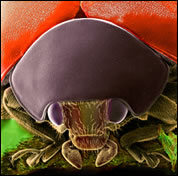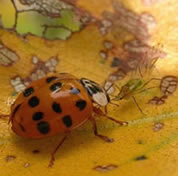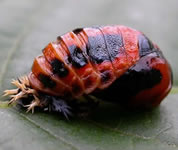![]()

Scanning Electron Micrograph of ladybird pronotum
Many people do not realise that we have so many different ladybirds living in Britain: 46 species. Not all of them are brightly coloured and spotty; some are really quite dull looking and are not recognisable as ladybirds. There are 27 species from the ladybird family (scientifically called the Coccinellidae) that actually look like ladybirds and here are some fun facts about them.
![]()
The most common species of ladybird in Britain is the seven-spot ladybird. This bright red ladybird has seven spots and is thought to have inspired the name ladybird: "Lady" referring to the Virgin Mary (Our lady) who in early paintings is seen wearing a red cloak; the seven spots are symbolic of the seven joys and seven sorrows of Mary.
![]()

Harlequin munching an aphid
A few species feed on plants or mildew but most ladybirds eat aphids (greenfly) or scale insects. Both are garden pests and this is why so many people love to see ladybirds. The seven-spot ladybird can eat 5000 aphids during its year long lifespan.
![]()
No! The number of spots does not relate to age at all!
![]()
No. When an adult ladybird is formed, it stays the same size for the rest of its life. Humans have a skeleton inside their bodies, called an "endoskeleton", but beetles like ladybirds have theirs outside (an "exoskeleton"). This hard skeletal outside means that they can't grow any bigger.
![]()
The bright colours warn potential enemies such as predators that ladybirds are not at all tasty. This so called "warning colouration" reminds predators of previous distasteful encounters with ladybirds!

This is called "reflex blood". It is very strong smelling and contains the toxins which make ladybirds off-putting to so many predators. Ladybirds do not die after producing reflex blood; it is part of their warning system.
![]()

Harlequin ladybird pupa
Ladybird adults spend the cold winter months in a dormant state. As the weather warms up in late February and March the adults begin to get active and search for early aphids to eat. The adults mate in the spring and the females lay eggs during the spring and early summer. This generation of adults then dies as the new generation hatches out.
The newly emerged larvae (immature ladybirds) do not look anything like their parents; they are black and grub-like. During this stage they eat lots and shed their skin three times before pupating. The pupa stage lasts about a week and from this the new adult emerges. The new adults must eat lots of aphids to build up reserves to see them through the winter months.
![]()
If you have any questions you would like to ask the Ladybird Survey Team then please e-mail us: ladybird-survey@ceh.ac.uk
